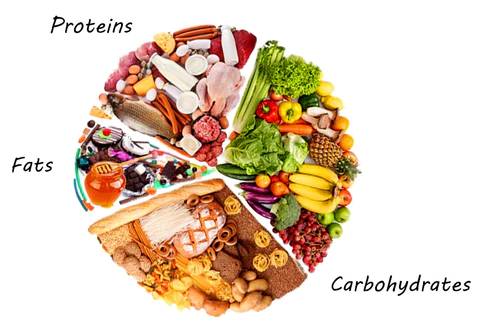Macronutrients (carbohydrates, protein, and fat) are the main components of the food and beverages in our diets. Each macronutrient has a caloric weight: carbs and protein have 4 calories per gram, fat has 9 calories per gram. The body uses these nutrients to repair, build, maintain, and fuel itself. Some of the specifics are listed below:
- Protein- used for metabolic reactions, bodily coordination, and building/repairing cells and tissues
- Carbohydrates- Primary, preferred source of energy for the body and brain. Fiber, a type of carbohydrate, helps with digestion and cardiovascular health
- Fats- used for energy, insulation, organ protection, and hormone production

The amount of energy (calories) that these macronutrients provide contribute to your total caloric intake for the day. The percentage of this caloric contribution from each macronutrient, in relation to daily total caloric intake, is adjusted to change an individual’s macronutrient split. An example of a macronutrient split is listed below:
-
2000 total calories
-
50% Carbohydrates = 1000 calories/ 4 calories per gram = 250 grams
-
30% Protein = 600 calories/ 4 calories per gram = 150 grams
-
20% Fat = 400 calories/ 9 calories per gram ~ 44 grams
Why adjust?
Adjustments to your macronutrient split is a very meticulous process. The reason why people would begin to pay attention to this detail in nutrition is to aid in reaching a specific goal in their fitness or performance. Macronutrient percentages can have a significant impact in body composition and performance. However, it is important to note macronutrients do not have a direct impact on weight loss or weight gain. For example, eating more protein in belief that you will build more muscle, without having a grasp on your daily energy balance, is not going to get you the results you want. So make sure you understand the basics of ‘calories in vs. calories out’ before experimenting with macro percentages. Goal specific adjustments are normally used for trained individuals looking to further their progress or maximize results.
Fat Loss
Macronutrient splits are the foundation of many popular weight loss diets. The majority of diets focus restrictions on food groups and macros i.e low carb, low fat. Although some success stories drive their popularity, there are many factors that can affect the way an individual responds to macro splits, including: genetics, gender, training level, goals, metabolism and more. Every person’s individuality is why specific diets work better for some than others. A good guideline for a healthy diet and macro split allows you to meet your caloric and nutritional needs, while also hitting your goals.
Performance
Certain macro adjustments are common in athletes that have to meet certain weights or require large amounts of stored energy for their competition. Adjustments are made similar to that of training routines in order to properly fuel the body and ensure peak performance or weight at a specific time. Two examples involving carbohydrate adjustments for athletes are shown below.
-
Combat Sports - a drastic focus on reducing carbohydrate intake prior to weigh-in, due to the tendency for water to hold on to carbohydrates in the body. Manipulating carbohydrate intake for a short period of time may help them lose enough water weight to meet their weigh-in requirements if a “cut” is necessary.
-
Endurance Athletes - Overload on carbohydrates prior to competition in order to “overcompensate” muscle recovery. This allows for a better performance and increased stores of glycogen to fuel their performance longer in long sessions.


The two athletes require a large amount of energy, however they tend to adjust their carbohydrate percentages in opposite extremes. As with all manipulations in diet, it's important to highlight that long term extremes have been linked to higher mortality rates.¹ Therefore, a well balanced diet, including all nutrients, is important for overall health.² ³ Unsure where to begin? Most organizations in the health, fitness, and performance industry provide their positioning on macro splits.
Guidelines
As mentioned above, everyone is different. As science continues to evolve in this category, we see discrepancies among highly recognized organizations in macro split guidelines. However, organizations that focus on specificity and needs of each individual, level of training, and goals tend to be the best way to go about nutrition for active individuals.
According to the National Academy of Sports Medicine and Precision Nutrition, the average starting macronutrient split, accounting for activity type, is as follows:
-
Endurance and/or high volume exercise
-
Protein 25%, Carbohydrate 55%, Fat 20%
-
Bodybuilding, explosive power, conditioning, and strength exercise
-
Protein 30%, Carbohydrate 40%, Fat 30%
-
Absolute strength exercise
-
Protein 35%, Carbohydrate 25%, Fat 40%
These are great splits to start with according to your activity type. Adjustments from these baselines tend to occur depending on your genetics, training level, goal, and gender. For example, a pro, male bodybuilder looking to gain muscle will have a higher protein intake than a guy who has been training for 6 months to gain muscle. Higher muscle mass is directly related to the protein needed to sustain it and especially to build more.⁴

Adjustments for Body Composition
There are so many variables affecting why one would adjust each macronutrient, but to keep it simple we will look at noticeable changes and easy adjustments that will affect the overall macro split. Below are the different body types/metabolisms, however some data shows that these classifications may be able to be manipulated overtime and are not of large importance.
-
“Hardgainer”
-
Typically looking to gain muscle
-
Increased carbohydrate intake
-
Gains and loses easily
-
Typically looking to gain muscle or lose fat
-
Moderate carbohydrate intake
-
Struggles to lose
-
Typically looking to lose fat
Some easy indicators and changes you can make along the way are as follows:⁴
-
Losing weight
-
Not losing fat within safe guidelines - remove 250 calories from carbs and/or fat
-
Losing too much muscle - increase daily protein intake by about 25 grams
-
Gaining weight
-
Not gaining muscle within safe guidelines - add 250 calories from carbs and/or fat
-
Adding too much fat while gaining muscle - replace 250 calories from carbs and/or fat with 25 grams of protein
If It Fits Your Macros (IIFYM)
IIFYM is a prime example of a diet that revolves solely around macronutrient and caloric intake. Basically, you can eat anything you want throughout the day as long as you meet your caloric needs for the day and stay within your macro split.⁷
-
Pros:
-
Very flexible with food variety
-
Easy way to begin accounting for macros
-
Ensures proper amounts of macros to sustain the body
-
Cons:
-
Neglects minimum micronutrient guidelines
-
Disregards a healthy and minimally processed diet as opposed to “junk” food
Recap
Macronutrient adjustments are a great way to improve performance and dial in on body composition goals. It is recommended for anyone who has a foundational knowledge in their training and nutrition, however it does require patience and a systematic “trial and error” to find what works for you. That being said, a dietician or nutrition expert should be consulted in beginning stages or if you are unsure of how to approach macronutrient splits.
Commonly prescribed for athletes and weight management clients, this method requires quite a bit of diligence and awareness of your nutrition. To make life easier, we recommend using tracking apps, scales, and/or measuring tools to log what you eat daily. Above all else, make sure you meet your caloric needs, eat nutrient-dense foods, and properly refuel for a full recovery around training sessions.


